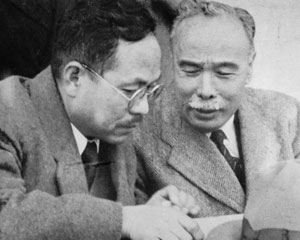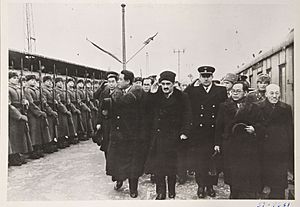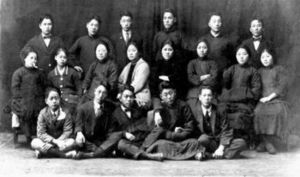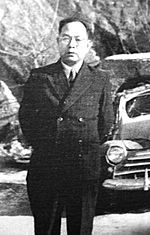Pak Hon-yong facts for kids
Quick facts for kids
Pak Hon-yong
|
|
|---|---|
|
박헌영
|
|

Pak Hon-yong in 1948
|
|
| Vice Chairman of the Workers' Party of Korea Central Committee | |
| 2nd Central Committee | |
| In office 24 June 1949 – 6 August 1953 Serving with Ho Ka-i
|
|
| Chairman | Kim Il-sung |
| Vice Premier of the Cabinet | |
| 1st Cabinet of North Korea | |
| In office 9 September 1948 – 3 March 1953 |
|
| Premier | Kim Il-sung |
| Minister of Foreign Affairs | |
| 1st Cabinet of North Korea | |
| In office 9 September 1948 – 3 March 1953 |
|
| Premier | Kim Il-sung |
| Preceded by | Post established |
| Succeeded by | Nam Il |
| Vice Chairman of the Workers' Party of South Korea Central Committee | |
| In office 24 November 1946 – 30 June 1949 Serving with Yi Ki-sok
|
|
| Chairman | Ho Hon |
| Chairman of the Communist Party of Korea Central Committee | |
| In office 14 September 1945 – 24 November 1946 |
|
| Preceded by | Post established |
| Succeeded by | Ho Hon |
| Personal details | |
| Born | 28 May 1900 Yesan, South Chungcheong Province, Korean Empire (now South Korea) |
| Died | 18 December 1955 (aged 55) Pyongyang, North Korea |
| Citizenship | North Korean |
| Nationality | Korean |
| Spouses | Joo Se-juk, Jung Sunnyen, Yi Sunkeum, Yun Lena |
| Children | Daughter: Vivian Park, Nathesa Park Son: Park Byungsam |
| Parents | Lee Hakkyu (Mother) Park Hyin-ju (Father) |
| Education | Kyŏngsŏng Ordinary High School(1919) |
| Alma mater | KyungKi High School International Lenin School |
| Korean name | |
| Chosŏn'gŭl | |
| Hancha | |
| Revised Romanization | Bak Heon-yeong |
| McCune–Reischauer | Pak Hŏnyŏng |
| Art name | |
| Chosŏn'gŭl | |
| Hancha | |
| Revised Romanization | Ijeong, Ichun |
| McCune–Reischauer | Ijŏng, Ich'un |
| Courtesy name | |
| Chosŏn'gŭl | |
| Hancha | |
| Revised Romanization | Tŏgyŏng |
| McCune–Reischauer | Deogyeong |
Pak Hon-yong (Korean: 박헌영; Hanja: 朴憲永; born May 28, 1900 – died December 18, 1955) was an important Korean leader. He fought for Korea's freedom and was a key figure in the communist movement. This movement aimed to create a society where everyone was equal and shared resources.
During the time Japan ruled Korea (1910–1945), Pak Hon-yong tried to create a Communist Party in Korea. When the Japanese government tried to stop him, he had to hide. After Korea became free in August 1945, he helped set up the Communist Party of Korea in the southern part of the country.
However, the American authorities in the South put pressure on him. So, in April 1948, he moved to North Korea. He met with other leaders like Kim Gu and Kim Kyu-sik to talk about reuniting Korea.
Later, he worked with Kim Il-sung during the Korean War. Pak Hon-yong was surprised by how strongly President Syngman Rhee in the South opposed his ideas. After the Korean War ended, Pak Hon-yong was accused of being an American spy. This accusation was not true. He was sentenced to death in 1955. Even though other countries like the Soviet Union and China tried to stop it, Pak was executed.
Contents
Pak Hon-yong's Early Life
Pak Hon-yong was born on May 28, 1900, in Yesan County, which is now in South Korea. His family was from a noble class called yangban. However, he was the son of a second wife, which was less common at the time.
In 1919, he finished high school at Kyŏngsŏng Ordinary High School, which is now Kyunggi High School. In March of that same year, he joined the March 1st Movement. This was a big protest where Koreans demanded independence from Japan. He continued to be involved in other movements for Korea's freedom.
Getting Involved in Politics
In 1921, Pak Hon-yong joined a branch of the Communist Party of Korea in Shanghai, China. He became a secretary for the Korean Communist Youth League. In January 1922, he went to a big meeting in Moscow, Russia, for people from the Far East.
In April 1922, Pak Hon-yong was arrested in Korea. He was accused of organizing the Communist Party. He was released in 1924. After that, he worked as a reporter for famous newspapers like Dong-a Ilbo and Chosun Ilbo.
Working in Secret
On April 18, 1925, Pak Hon-yong helped start the Communist Party of Korea. From this time until the end of World War II, he had to work in secret. This was because the Japanese authorities did not allow such political groups.
In 1926, he had to go to court. During his trial, he pretended to be mentally unwell. This led to him being found not guilty in November of that year. He was then kept at home because of his supposed illness. But in December, he escaped through Manchukuo (a region in China) to reach the Soviet Union. It was only then that the Japanese realized he had been faking his illness.
In the Soviet Union, he studied at the International Lenin School. He returned to Korea in 1940. Back home, he continued his secret work against Japanese rule.
After Korea's Freedom

In late August 1945, after World War II ended and Korea became free, the Communist Party of Korea was started again. It had been officially closed down in 1928. Pak Hon-yong became its secretary. On January 5, 1946, he spoke at a press conference. He announced that Korea was beginning a "democratic revolution." This was based on a decision made by powerful countries (the UK, US, and Soviet Union) at a meeting in Moscow. After this meeting, the Communist Party of Korea faced difficulties from the American military government in the South.
In September 1946, he helped organize a huge general strike. At its busiest, more than 250,000 workers took part.
In December 1946, he helped create the Workers Party of South Korea. He became one of its two vice chairmen.
Working for Korea's Future

In April 1948, Pak Hon-yong traveled to North Korea for important talks. He went with Kim Gu and Kim Kyu-sik. These talks ended in May 1948, and Pak decided to stay in the North.
In September 1948, North Korea was officially established. Pak Hon-yong kept his role as secretary of the Workers' Party of South Korea. He also became the Deputy Prime Minister and Foreign Minister of the new North Korean government.
When the North and South Korean parties joined together in April 1950, Pak Hon-yong became secretary of the Workers' Party of Korea. He was also the vice chairman of the Politburo (a top political group) of North Korea from 1949 to 1953. He served as Foreign Minister until he was removed from his position and arrested in 1953.
Role in the Korean War
Secret documents from the former Soviet Union show that Kim Il-sung and Pak Hon-yong worked closely together. They planned the Korean War in detail. They visited Moscow from March 30 to April 25, 1950. During this visit, they met with Joseph Stalin, the leader of the Soviet Union. Stalin approved their war plans and gave them written instructions.
Arrest and Final Years
Pak Hon-yong was arrested on August 3, 1953. This happened during a time when Kim Il-sung was removing former members of the Workers' Party of South Korea from power. On December 15, 1955, Pak was sentenced to death. He was accused of being a spy, but this accusation was made up. The exact date of his execution is not fully known, but it is believed to have happened in December 1955.
See also
 In Spanish: Pak Heon-yeong para niños
In Spanish: Pak Heon-yeong para niños
- Communist Party of Korea
- Workers' Party of South Korea
- Workers' Party of Korea
- Kim Gu
- Kim Il-sung
- Kim Kyu-sik
- Kim Won-bong
- Yuh Woon-hyung
- Korean independence movement
- Politics of North Korea



